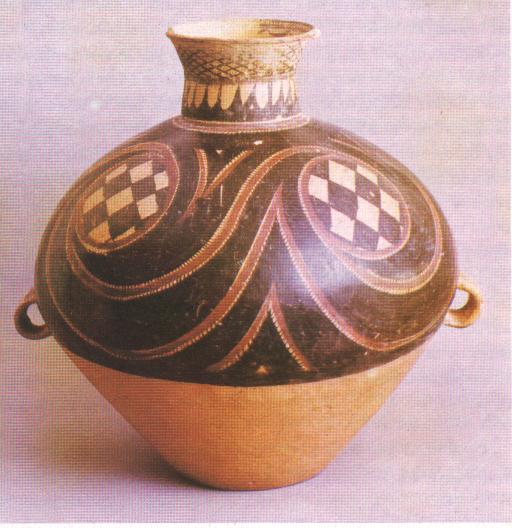 Chinese
ceramics began with the people of the Yangshao culture in about the year
5000 B.C. near the Wei River. Two major types of pottery were made
at this time. The first was gray everyday earthenware that often
was minimally decorated with “cord, mat, or basket impressions” (Blunden
53). The second type of pottery is more intricate as well as beautiful.
These earthenware pots have a “lightly burnished surface decorated with
painted designs in black, red, maroon, and brown” (53). The decorations
are generally simple geometric patterns such as swirls, but they can be
more ornate and include stylized fish, birds, and human faces (Gernet 39).
As the culture spread westward, the pottery “from the Kansu sites…displays
more elaborate designs” (39). This type of highly decorated pottery
seems to have been used primarily for funerary practices. Chinese
ceramics began with the people of the Yangshao culture in about the year
5000 B.C. near the Wei River. Two major types of pottery were made
at this time. The first was gray everyday earthenware that often
was minimally decorated with “cord, mat, or basket impressions” (Blunden
53). The second type of pottery is more intricate as well as beautiful.
These earthenware pots have a “lightly burnished surface decorated with
painted designs in black, red, maroon, and brown” (53). The decorations
are generally simple geometric patterns such as swirls, but they can be
more ornate and include stylized fish, birds, and human faces (Gernet 39).
As the culture spread westward, the pottery “from the Kansu sites…displays
more elaborate designs” (39). This type of highly decorated pottery
seems to have been used primarily for funerary practices.
From a more mechanical and less aesthetic viewpoint, the Yangshao potters
began the long tradition of combining function, form, and painting into
their ceramics. The Yangshao had a small repertoire of shapes that
included bowls and jars. The usual baking temperature was 1000-1500°C
(39). Both the coarser gray ware and the highly burnished pottery were
hand built. The gray ware was built “with coils of clay, and smoothed
over to conceal the joins” (Blunden 53). The burnished pottery was
built up in a similar fashion but was of a higher quality of workmanship.
Much of the decoration on the burnished pottery was painted on with slips,
which are solutions of metals. The Yangshao used “colours deriving
from iron and manganese producing black, dark brown, and maroon.
A later addition was the white slip which heightened the decoration in
a striking manner” (Hook, 387). From these discoveries, decoration
blossomed, and even in this early time of Chinese culture embellishment
upon the pottery was “highly stylized, yet it exhibits the vitality and
rhythm which is to characterize all Chinese art” (Morton 12).
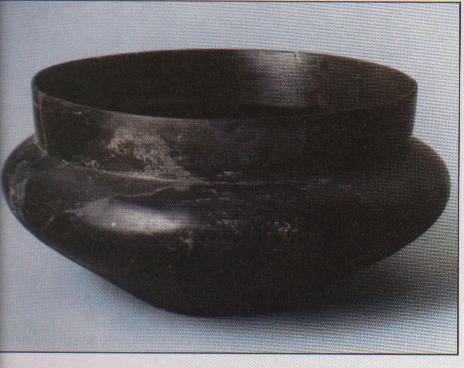 Types of pottery are the central division among Chinese Neolithic cultures.
The Yangshao, as described above, had two main types, with the burnished,
highly decorated pottery being the hallmark style. Following the
Yangshao is the Longshan culture, beginning in approximately 4500 B.C.
and overlapping with the Yangshao for 1500 years. The Longshan were
generally farther east compared to the Yangshao, but some excavation sites
have the Longshan directly succeeding the Yangshao. Like their predecessors,
the Longshan had two types of pottery, but only one is studied with great
care. The Longshan share the more functional gray wares with their
predecessors. The key difference between the cultures is the Longshan
blackware. There are some immediate differences from the highly decorated
Yangshao pieces. First, the Longshan wares are significantly thinner
due to the fact that the vessels were thrown on a potter’s wheel rather
than built by hand. This may have been a consequence of being farther
east and having more contact with the Koreans. Second, Longshan pottery
is has no decoration. These blackwares were made by firing the iron
poor clays initially and then exposing them to smoke. The smoke could
be “penetrated deep into the hot porous ceramics, turning them a fine black
colour- a process known as carbonizing. If the ceramics had been
burnished before firing the result was a deep and glossy black” (Wood 14).
Another major difference in the Longshan pottery is its form, which is
“angular in outline and extremely elegant…Some shapes are already close
to those vessels of the Bronze Age”(Gernet 39). Although the Longshan
culture ends around 2500 B.C., there are no new defining styles of pottery
until the Shang dynasty of 1766 B.C.
Types of pottery are the central division among Chinese Neolithic cultures.
The Yangshao, as described above, had two main types, with the burnished,
highly decorated pottery being the hallmark style. Following the
Yangshao is the Longshan culture, beginning in approximately 4500 B.C.
and overlapping with the Yangshao for 1500 years. The Longshan were
generally farther east compared to the Yangshao, but some excavation sites
have the Longshan directly succeeding the Yangshao. Like their predecessors,
the Longshan had two types of pottery, but only one is studied with great
care. The Longshan share the more functional gray wares with their
predecessors. The key difference between the cultures is the Longshan
blackware. There are some immediate differences from the highly decorated
Yangshao pieces. First, the Longshan wares are significantly thinner
due to the fact that the vessels were thrown on a potter’s wheel rather
than built by hand. This may have been a consequence of being farther
east and having more contact with the Koreans. Second, Longshan pottery
is has no decoration. These blackwares were made by firing the iron
poor clays initially and then exposing them to smoke. The smoke could
be “penetrated deep into the hot porous ceramics, turning them a fine black
colour- a process known as carbonizing. If the ceramics had been
burnished before firing the result was a deep and glossy black” (Wood 14).
Another major difference in the Longshan pottery is its form, which is
“angular in outline and extremely elegant…Some shapes are already close
to those vessels of the Bronze Age”(Gernet 39). Although the Longshan
culture ends around 2500 B.C., there are no new defining styles of pottery
until the Shang dynasty of 1766 B.C.
The Shang dynasty is considered a part of the Chinese Bronze Age and
therefore ceramics during this time period are generally not spectacular.
Nigel Wood, an expert of Chinese ceramics, states, “Ceramics from China’s
early Bronze Age are generally considered inferior, both in design and
finish, to the Neolithic ceramics” (14). Wood suggests that the quality
decreased because of the increased use of bronze vessels in rituals and
mortuary practices. Instead of showcasing a particular style of pottery,
the coarse gray ware with cord markings continued to dominate, and much
of the ceramic wares found from the Shang are molds for bronzes.
 Very
much like the Shang dynasty, the Zhou dynasty (1027-221 B.C.) did not put
great emphasis on their ceramics. Once again the simple, coarse gray
wares were the main type of pottery produced. The Zhou dynasty did
craft some unique wares including glazed stoneware that was decorated by
both painting and dipping. The wares of the Eastern Zhou (771-221
B.C.) tend to follow the fads of the bronzes because they were an inexpensive
alternative to the bronze vessels used in rituals. These “bargain”
funeral wares of the Warring States period were often made from “fine siliceous
stoneware clays with yellowish, greeny-gray, or dark brown glazes” (Wood
20). The end of the Zhou dynasty marked an important change in China’s
history because the dynasty to follow was the first to unite all of China,
so technically the first truly “Chinese” ceramics were produced during
the Qin. Very
much like the Shang dynasty, the Zhou dynasty (1027-221 B.C.) did not put
great emphasis on their ceramics. Once again the simple, coarse gray
wares were the main type of pottery produced. The Zhou dynasty did
craft some unique wares including glazed stoneware that was decorated by
both painting and dipping. The wares of the Eastern Zhou (771-221
B.C.) tend to follow the fads of the bronzes because they were an inexpensive
alternative to the bronze vessels used in rituals. These “bargain”
funeral wares of the Warring States period were often made from “fine siliceous
stoneware clays with yellowish, greeny-gray, or dark brown glazes” (Wood
20). The end of the Zhou dynasty marked an important change in China’s
history because the dynasty to follow was the first to unite all of China,
so technically the first truly “Chinese” ceramics were produced during
the Qin.
The Qin dynasty was extremely short, only fifteen years, lasting between
221 and 206B.C. Obviously this short amount of time was not enough
to create a unique style of ceramics or glaze, but the Qin dynasty is noteworthy
because of the tomb of Qin Shi Huangdi, the first emperor of China.
Qin Shi Huangdi’s tomb is outfitted with an entire division of infantry
and cavalry that consists of over “7,000 life-size earthenware soldiers
equipped with real weapons, real chariots, and pottery horses” (Huang 37).
The tomb is an awesome archeological find due not only to its size, but
also its accuracy. Each soldier has a unique facial expression, hairdo,
armor, and stance. Qin Shi Huangdi’s tomb represents a breakthrough
in production of earthenwares and showcases the creative capability of
thousands of anonymous artisans.
The Han dynasty (202 B.C.-220 A.D.), which follows the Qin, exhibits
an intriguing dichotomy because great unity and peace was brought to China
with the establishment of the new dynasty, yet the Han’s most important
contribution to the history of China’s ceramics is the fact that this time
period brings about the first noticeable difference in Northern and Southern
wares. According to The Cambridge Encyclopedia of China, “In
the north lead-glazed ceramics tended to be simply cheap substitutes for
bronzes and intended for tombs, but in the south ceramics were developed
more in their own right”(Hook 404). The common wares were often red
or gray with high-fired glazes. Wares used for funerary purposes
often used glazes that were “reminiscent of bronze in its various states
of patination and early Han lead-glazed vessels often followed the shapes
of Han bronzes” (Wood 191). Han discoveries were the early prototypes
for glazes used during the Tang and Song dynasties in sancai wares.
 The Tang
dynasty (618-907 A.D.) is arguably the most significant time period in
the evolution of Chinese ceramics because porcelain, the epitome of Chinese
stoneware, was discovered during this dynasty. Even more astounding,
porcelain is not the only development that occurred during the Tang dynasty.
Sancai, also known as “three-colour” wares, were also developed using new
high-lead glazes that produced a plethora of color combinations (Hook 409).
Another addition was marbled pottery, which used different colored clays
to create a swirled look that was painted with a transparent glaze (409).
The final development was expanding the repertoire of shapes of vessels,
many of which were influenced by contacts with the West. During this
time, vases and bowls became quite novel and popular. The interest
in different clay colors used in the marbled pottery helped bring about
the discovery of porcelain, which “evolved out of the conscious attempts
to produce a pure white clay body” (Tharp). The Tang
dynasty (618-907 A.D.) is arguably the most significant time period in
the evolution of Chinese ceramics because porcelain, the epitome of Chinese
stoneware, was discovered during this dynasty. Even more astounding,
porcelain is not the only development that occurred during the Tang dynasty.
Sancai, also known as “three-colour” wares, were also developed using new
high-lead glazes that produced a plethora of color combinations (Hook 409).
Another addition was marbled pottery, which used different colored clays
to create a swirled look that was painted with a transparent glaze (409).
The final development was expanding the repertoire of shapes of vessels,
many of which were influenced by contacts with the West. During this
time, vases and bowls became quite novel and popular. The interest
in different clay colors used in the marbled pottery helped bring about
the discovery of porcelain, which “evolved out of the conscious attempts
to produce a pure white clay body” (Tharp).
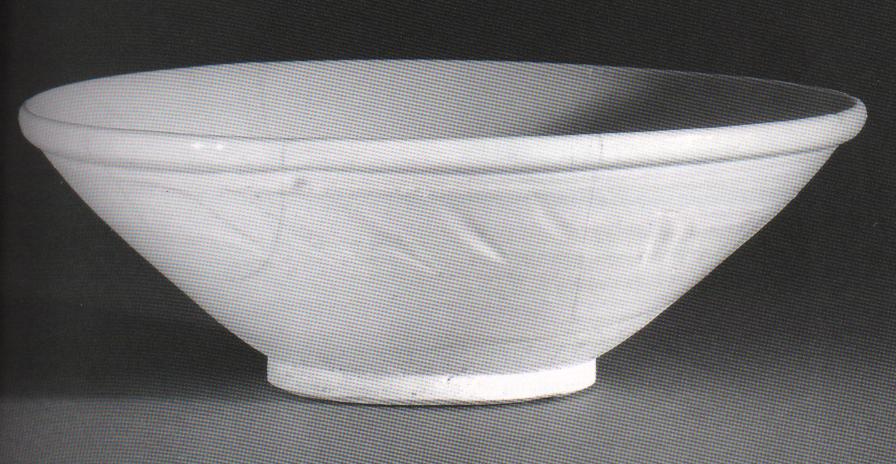 There are three major types of Tang porcelain designated by the region
in which the producing kilns were located. The first type is early
whiteware created in Gongxian in the northern part of the Henan province.
Gongxian porcelains had good translucency, and their glazes had good resistance
to dullness and crazing (Wood 97). The porcelains made in Gongxian
included plain whitewares as well as blue and whites, which are porcelains
with a cobalt blue underglaze. Xing porcelain is the most famous
Tang porcelain because it was the whitest produced in the north.
A combination of extremely pure clay and high firing temperatures, as high
as white-blue heat or 1350°C, was needed to produce such white porcelain
(99). The final type of Tang porcelain is known as Ding ware.
During the Tang, Ding ware was considered inferior to the Xing because
of its creamy color. This opinion of Ding inferiority changed during
the Song dynasty.
There are three major types of Tang porcelain designated by the region
in which the producing kilns were located. The first type is early
whiteware created in Gongxian in the northern part of the Henan province.
Gongxian porcelains had good translucency, and their glazes had good resistance
to dullness and crazing (Wood 97). The porcelains made in Gongxian
included plain whitewares as well as blue and whites, which are porcelains
with a cobalt blue underglaze. Xing porcelain is the most famous
Tang porcelain because it was the whitest produced in the north.
A combination of extremely pure clay and high firing temperatures, as high
as white-blue heat or 1350°C, was needed to produce such white porcelain
(99). The final type of Tang porcelain is known as Ding ware.
During the Tang, Ding ware was considered inferior to the Xing because
of its creamy color. This opinion of Ding inferiority changed during
the Song dynasty.
 The artisans of the Song dynasty (960-1279 A.D.) perfected what those in
the Tang had begun. The hallmark of Song ceramics is monochrome porcelain
with exquisite form. Ding ware, formally considered second rate,
developed into “plain and beautiful cream-coloured, oxidised porcelain
with austere and refined forms that showed a superb balance of inner and
outer space” (100-1). Decorations changed significantly from the
vibrant colors used in the Tang to the more subdued monochrome glazes and
incised designs. The evolution of Ding ware came to a point when
it was declared the “official palace ware of
The artisans of the Song dynasty (960-1279 A.D.) perfected what those in
the Tang had begun. The hallmark of Song ceramics is monochrome porcelain
with exquisite form. Ding ware, formally considered second rate,
developed into “plain and beautiful cream-coloured, oxidised porcelain
with austere and refined forms that showed a superb balance of inner and
outer space” (100-1). Decorations changed significantly from the
vibrant colors used in the Tang to the more subdued monochrome glazes and
incised designs. The evolution of Ding ware came to a point when
it was declared the “official palace ware of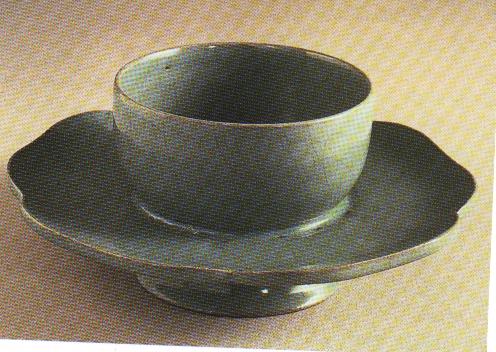 the Northern Song emperors” (Hook 411). Unfortunately, the notoriety
of Ding ware did not last very long for the royal family and was replaced
with Ru ware, “a fine, undecorated ware with a pale grey-green glaze usually
with a faint crackle” (411). The Song had managed to perfect the
creation of vessels to the point where “most of the pots are fully glazed
(including foot and base), because in the kiln the vessels were placed
on tiny supports called spurs that left only minute “sesame-seed” marks
on the glaze” (“Northern Song”). It is said that the Song dynasty
was the time of perfection for Chinese ceramics, and that nothing could
ever compare with it again.
the Northern Song emperors” (Hook 411). Unfortunately, the notoriety
of Ding ware did not last very long for the royal family and was replaced
with Ru ware, “a fine, undecorated ware with a pale grey-green glaze usually
with a faint crackle” (411). The Song had managed to perfect the
creation of vessels to the point where “most of the pots are fully glazed
(including foot and base), because in the kiln the vessels were placed
on tiny supports called spurs that left only minute “sesame-seed” marks
on the glaze” (“Northern Song”). It is said that the Song dynasty
was the time of perfection for Chinese ceramics, and that nothing could
ever compare with it again.
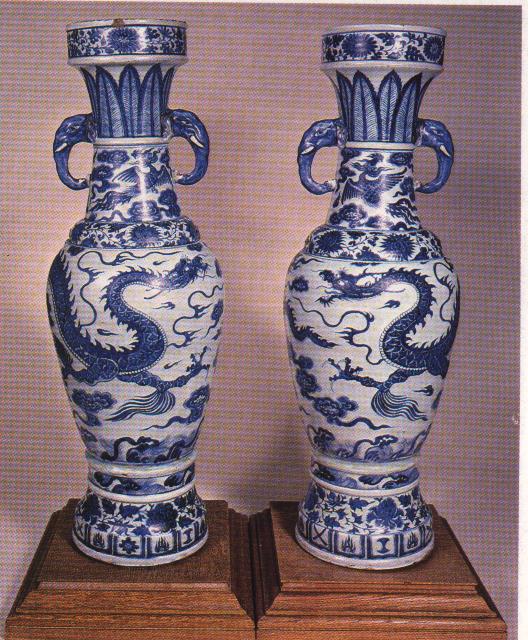 The Yuan
dynasty (1260-1368 A.D.) unfortunately did not keep up to the standards
set by the Song. Although the forms of Yuan and Song pottery are
similar, the excellence in balanced form of the Song was not to be met
by the Yuan. Wares became “heavier and cruder, with new shapes such
as large dishes and bowls” (Hook 413). Even though Yuan wares are
disappointing in aspects such as style and form, decoration is the Yuan’s
saving grace. Images became much more dramatic, naturalistic, and
dynamic. Glazes became less pure, but underglazing with qingbai,
a “thicker and more opaque glaze,” brought about the unquestionably Chinese
blue and white porcelain (413). The Yuan
dynasty (1260-1368 A.D.) unfortunately did not keep up to the standards
set by the Song. Although the forms of Yuan and Song pottery are
similar, the excellence in balanced form of the Song was not to be met
by the Yuan. Wares became “heavier and cruder, with new shapes such
as large dishes and bowls” (Hook 413). Even though Yuan wares are
disappointing in aspects such as style and form, decoration is the Yuan’s
saving grace. Images became much more dramatic, naturalistic, and
dynamic. Glazes became less pure, but underglazing with qingbai,
a “thicker and more opaque glaze,” brought about the unquestionably Chinese
blue and white porcelain (413).
Although the Ming dynasty (1368-1644 A.D.) is best known for its blue
and white porcelain, many types of unique ceramics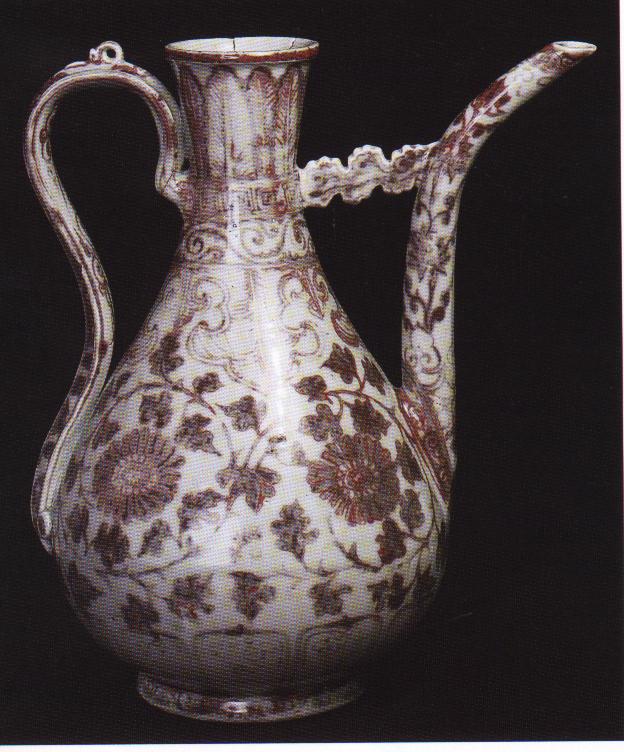 were developed at this time. The kilns that produced the best quality
and quantity of wares were concentrated at Jingdezhen in the Jiangzi province
because of the deposits of kaolin and petuntse, the most important elements
for porcelain making (416). The kaolin is the key to making very
thin vessels because when heated to high temperatures, upwards of 1,300-1,500°C,
the kaolin becomes extremely hard and strong without too much clay so the
vessels could be made to be almost translucent (Morton 129). These
kilns produced blue and white porcelain along with “red monochromes, and
‘bodiless’
were developed at this time. The kilns that produced the best quality
and quantity of wares were concentrated at Jingdezhen in the Jiangzi province
because of the deposits of kaolin and petuntse, the most important elements
for porcelain making (416). The kaolin is the key to making very
thin vessels because when heated to high temperatures, upwards of 1,300-1,500°C,
the kaolin becomes extremely hard and strong without too much clay so the
vessels could be made to be almost translucent (Morton 129). These
kilns produced blue and white porcelain along with “red monochromes, and
‘bodiless’ 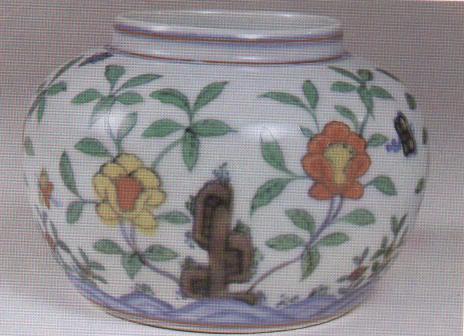 imperial wares…[with] anhua, incised in the body under the glaze, visible
only when held up to the light” (Hook 416). Another type of ware
produced at the imperial kilns was doucai, porcelain vessels enameled with
many colors. The effect of doucai is a “true polychrome effect, combining
red, yellow, green, brown, and aubergine overglaze enamels with underglaze
blue” (Wood 233). The popularity of Ming wares could not be stopped,
and large-scale production continued into the Qing dynasty.
imperial wares…[with] anhua, incised in the body under the glaze, visible
only when held up to the light” (Hook 416). Another type of ware
produced at the imperial kilns was doucai, porcelain vessels enameled with
many colors. The effect of doucai is a “true polychrome effect, combining
red, yellow, green, brown, and aubergine overglaze enamels with underglaze
blue” (Wood 233). The popularity of Ming wares could not be stopped,
and large-scale production continued into the Qing dynasty.
The hallmark of the wares of the Qing dynasty (1644-1911 A.D.) was production
over aesthetics or form. Eventually the imperial kilns exchanged
the blue and white wares for the polychrome enamelwares. Two main
types of enamelwares were  produced. The first was famille noire. These wares have a characteristic
blackish-green background. The second type is known as famille rose,
which usually have a white background and the decorations consist of flowers
or birds in yellows and pinks.
produced. The first was famille noire. These wares have a characteristic
blackish-green background. The second type is known as famille rose,
which usually have a white background and the decorations consist of flowers
or birds in yellows and pinks.  Although the Qing developed extraordinary kilns and production systems,
the secret of porcelain making reached Europe and export immediately decreased.
The need to produce large amounts of porcelain was essentially eliminated.
Although the Qing developed extraordinary kilns and production systems,
the secret of porcelain making reached Europe and export immediately decreased.
The need to produce large amounts of porcelain was essentially eliminated.
This paper represents over 7,000 years of ceramic history from the Yangshao’s
simple burnished vessels to the Qing’s technical perfection of production
of porcelain. Although each dynasty certainly has its own unique
features, every style is undeniably Chinese. Aesthetics and function
meld together seamlessly in every object to allow for pleasing yet useful
objects that continue to astound people around the world.
|
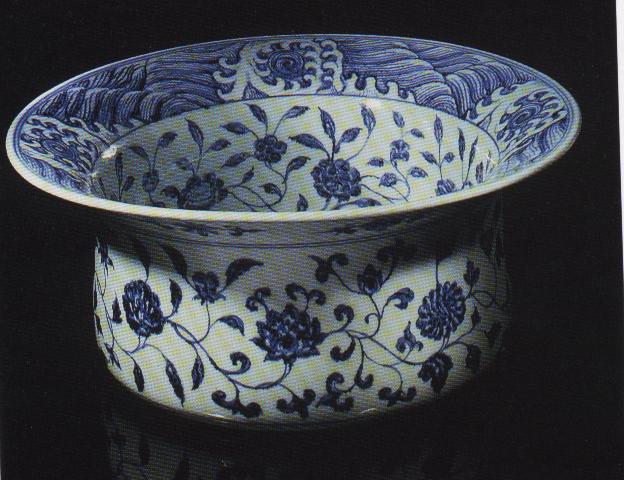 Most
often when thinking about Asian ceramics, fine porcelain commonly known
in the West as “china” comes to mind. Where did porcelain come from?
How did the Chinese manage to perfect its manufacturing so many hundreds
of years before the West? These questions can be answered by realizing
that porcelain is only one of many types of ceramics that the Chinese developed
throughout their history. In fact, porcelain came quite late in China’s
history, but its effect on the West is what makes it special. Ceramics
in China can be traced back to the earliest known culture, the Yangshao.
Every culture or dynasty that followed the Yangshao had its own unique
earthenware or stoneware that helped define that particular time period.
This paper will examine the evolution of Chinese ceramics, in both their
components and glazes, beginning with the Yangshao culture thru the Qing
dynasty in order to better understand how the Chinese became so proficient
in making the finest ceramics in the world.
Most
often when thinking about Asian ceramics, fine porcelain commonly known
in the West as “china” comes to mind. Where did porcelain come from?
How did the Chinese manage to perfect its manufacturing so many hundreds
of years before the West? These questions can be answered by realizing
that porcelain is only one of many types of ceramics that the Chinese developed
throughout their history. In fact, porcelain came quite late in China’s
history, but its effect on the West is what makes it special. Ceramics
in China can be traced back to the earliest known culture, the Yangshao.
Every culture or dynasty that followed the Yangshao had its own unique
earthenware or stoneware that helped define that particular time period.
This paper will examine the evolution of Chinese ceramics, in both their
components and glazes, beginning with the Yangshao culture thru the Qing
dynasty in order to better understand how the Chinese became so proficient
in making the finest ceramics in the world.
 Chinese
ceramics began with the people of the Yangshao culture in about the year
5000 B.C. near the Wei River. Two major types of pottery were made
at this time. The first was gray everyday earthenware that often
was minimally decorated with “cord, mat, or basket impressions” (Blunden
53). The second type of pottery is more intricate as well as beautiful.
These earthenware pots have a “lightly burnished surface decorated with
painted designs in black, red, maroon, and brown” (53). The decorations
are generally simple geometric patterns such as swirls, but they can be
more ornate and include stylized fish, birds, and human faces (Gernet 39).
As the culture spread westward, the pottery “from the Kansu sites…displays
more elaborate designs” (39). This type of highly decorated pottery
seems to have been used primarily for funerary practices.
Chinese
ceramics began with the people of the Yangshao culture in about the year
5000 B.C. near the Wei River. Two major types of pottery were made
at this time. The first was gray everyday earthenware that often
was minimally decorated with “cord, mat, or basket impressions” (Blunden
53). The second type of pottery is more intricate as well as beautiful.
These earthenware pots have a “lightly burnished surface decorated with
painted designs in black, red, maroon, and brown” (53). The decorations
are generally simple geometric patterns such as swirls, but they can be
more ornate and include stylized fish, birds, and human faces (Gernet 39).
As the culture spread westward, the pottery “from the Kansu sites…displays
more elaborate designs” (39). This type of highly decorated pottery
seems to have been used primarily for funerary practices.
 Types of pottery are the central division among Chinese Neolithic cultures.
The Yangshao, as described above, had two main types, with the burnished,
highly decorated pottery being the hallmark style. Following the
Yangshao is the Longshan culture, beginning in approximately 4500 B.C.
and overlapping with the Yangshao for 1500 years. The Longshan were
generally farther east compared to the Yangshao, but some excavation sites
have the Longshan directly succeeding the Yangshao. Like their predecessors,
the Longshan had two types of pottery, but only one is studied with great
care. The Longshan share the more functional gray wares with their
predecessors. The key difference between the cultures is the Longshan
blackware. There are some immediate differences from the highly decorated
Yangshao pieces. First, the Longshan wares are significantly thinner
due to the fact that the vessels were thrown on a potter’s wheel rather
than built by hand. This may have been a consequence of being farther
east and having more contact with the Koreans. Second, Longshan pottery
is has no decoration. These blackwares were made by firing the iron
poor clays initially and then exposing them to smoke. The smoke could
be “penetrated deep into the hot porous ceramics, turning them a fine black
colour- a process known as carbonizing. If the ceramics had been
burnished before firing the result was a deep and glossy black” (Wood 14).
Another major difference in the Longshan pottery is its form, which is
“angular in outline and extremely elegant…Some shapes are already close
to those vessels of the Bronze Age”(Gernet 39). Although the Longshan
culture ends around 2500 B.C., there are no new defining styles of pottery
until the Shang dynasty of 1766 B.C.
Types of pottery are the central division among Chinese Neolithic cultures.
The Yangshao, as described above, had two main types, with the burnished,
highly decorated pottery being the hallmark style. Following the
Yangshao is the Longshan culture, beginning in approximately 4500 B.C.
and overlapping with the Yangshao for 1500 years. The Longshan were
generally farther east compared to the Yangshao, but some excavation sites
have the Longshan directly succeeding the Yangshao. Like their predecessors,
the Longshan had two types of pottery, but only one is studied with great
care. The Longshan share the more functional gray wares with their
predecessors. The key difference between the cultures is the Longshan
blackware. There are some immediate differences from the highly decorated
Yangshao pieces. First, the Longshan wares are significantly thinner
due to the fact that the vessels were thrown on a potter’s wheel rather
than built by hand. This may have been a consequence of being farther
east and having more contact with the Koreans. Second, Longshan pottery
is has no decoration. These blackwares were made by firing the iron
poor clays initially and then exposing them to smoke. The smoke could
be “penetrated deep into the hot porous ceramics, turning them a fine black
colour- a process known as carbonizing. If the ceramics had been
burnished before firing the result was a deep and glossy black” (Wood 14).
Another major difference in the Longshan pottery is its form, which is
“angular in outline and extremely elegant…Some shapes are already close
to those vessels of the Bronze Age”(Gernet 39). Although the Longshan
culture ends around 2500 B.C., there are no new defining styles of pottery
until the Shang dynasty of 1766 B.C.
 Very
much like the Shang dynasty, the Zhou dynasty (1027-221 B.C.) did not put
great emphasis on their ceramics. Once again the simple, coarse gray
wares were the main type of pottery produced. The Zhou dynasty did
craft some unique wares including glazed stoneware that was decorated by
both painting and dipping. The wares of the Eastern Zhou (771-221
B.C.) tend to follow the fads of the bronzes because they were an inexpensive
alternative to the bronze vessels used in rituals. These “bargain”
funeral wares of the Warring States period were often made from “fine siliceous
stoneware clays with yellowish, greeny-gray, or dark brown glazes” (Wood
20). The end of the Zhou dynasty marked an important change in China’s
history because the dynasty to follow was the first to unite all of China,
so technically the first truly “Chinese” ceramics were produced during
the Qin.
Very
much like the Shang dynasty, the Zhou dynasty (1027-221 B.C.) did not put
great emphasis on their ceramics. Once again the simple, coarse gray
wares were the main type of pottery produced. The Zhou dynasty did
craft some unique wares including glazed stoneware that was decorated by
both painting and dipping. The wares of the Eastern Zhou (771-221
B.C.) tend to follow the fads of the bronzes because they were an inexpensive
alternative to the bronze vessels used in rituals. These “bargain”
funeral wares of the Warring States period were often made from “fine siliceous
stoneware clays with yellowish, greeny-gray, or dark brown glazes” (Wood
20). The end of the Zhou dynasty marked an important change in China’s
history because the dynasty to follow was the first to unite all of China,
so technically the first truly “Chinese” ceramics were produced during
the Qin.
 The Tang
dynasty (618-907 A.D.) is arguably the most significant time period in
the evolution of Chinese ceramics because porcelain, the epitome of Chinese
stoneware, was discovered during this dynasty. Even more astounding,
porcelain is not the only development that occurred during the Tang dynasty.
Sancai, also known as “three-colour” wares, were also developed using new
high-lead glazes that produced a plethora of color combinations (Hook 409).
Another addition was marbled pottery, which used different colored clays
to create a swirled look that was painted with a transparent glaze (409).
The final development was expanding the repertoire of shapes of vessels,
many of which were influenced by contacts with the West. During this
time, vases and bowls became quite novel and popular. The interest
in different clay colors used in the marbled pottery helped bring about
the discovery of porcelain, which “evolved out of the conscious attempts
to produce a pure white clay body” (Tharp).
The Tang
dynasty (618-907 A.D.) is arguably the most significant time period in
the evolution of Chinese ceramics because porcelain, the epitome of Chinese
stoneware, was discovered during this dynasty. Even more astounding,
porcelain is not the only development that occurred during the Tang dynasty.
Sancai, also known as “three-colour” wares, were also developed using new
high-lead glazes that produced a plethora of color combinations (Hook 409).
Another addition was marbled pottery, which used different colored clays
to create a swirled look that was painted with a transparent glaze (409).
The final development was expanding the repertoire of shapes of vessels,
many of which were influenced by contacts with the West. During this
time, vases and bowls became quite novel and popular. The interest
in different clay colors used in the marbled pottery helped bring about
the discovery of porcelain, which “evolved out of the conscious attempts
to produce a pure white clay body” (Tharp).
 There are three major types of Tang porcelain designated by the region
in which the producing kilns were located. The first type is early
whiteware created in Gongxian in the northern part of the Henan province.
Gongxian porcelains had good translucency, and their glazes had good resistance
to dullness and crazing (Wood 97). The porcelains made in Gongxian
included plain whitewares as well as blue and whites, which are porcelains
with a cobalt blue underglaze. Xing porcelain is the most famous
Tang porcelain because it was the whitest produced in the north.
A combination of extremely pure clay and high firing temperatures, as high
as white-blue heat or 1350°C, was needed to produce such white porcelain
(99). The final type of Tang porcelain is known as Ding ware.
During the Tang, Ding ware was considered inferior to the Xing because
of its creamy color. This opinion of Ding inferiority changed during
the Song dynasty.
There are three major types of Tang porcelain designated by the region
in which the producing kilns were located. The first type is early
whiteware created in Gongxian in the northern part of the Henan province.
Gongxian porcelains had good translucency, and their glazes had good resistance
to dullness and crazing (Wood 97). The porcelains made in Gongxian
included plain whitewares as well as blue and whites, which are porcelains
with a cobalt blue underglaze. Xing porcelain is the most famous
Tang porcelain because it was the whitest produced in the north.
A combination of extremely pure clay and high firing temperatures, as high
as white-blue heat or 1350°C, was needed to produce such white porcelain
(99). The final type of Tang porcelain is known as Ding ware.
During the Tang, Ding ware was considered inferior to the Xing because
of its creamy color. This opinion of Ding inferiority changed during
the Song dynasty.
 The artisans of the Song dynasty (960-1279 A.D.) perfected what those in
the Tang had begun. The hallmark of Song ceramics is monochrome porcelain
with exquisite form. Ding ware, formally considered second rate,
developed into “plain and beautiful cream-coloured, oxidised porcelain
with austere and refined forms that showed a superb balance of inner and
outer space” (100-1). Decorations changed significantly from the
vibrant colors used in the Tang to the more subdued monochrome glazes and
incised designs. The evolution of Ding ware came to a point when
it was declared the “official palace ware of
The artisans of the Song dynasty (960-1279 A.D.) perfected what those in
the Tang had begun. The hallmark of Song ceramics is monochrome porcelain
with exquisite form. Ding ware, formally considered second rate,
developed into “plain and beautiful cream-coloured, oxidised porcelain
with austere and refined forms that showed a superb balance of inner and
outer space” (100-1). Decorations changed significantly from the
vibrant colors used in the Tang to the more subdued monochrome glazes and
incised designs. The evolution of Ding ware came to a point when
it was declared the “official palace ware of the Northern Song emperors” (Hook 411). Unfortunately, the notoriety
of Ding ware did not last very long for the royal family and was replaced
with Ru ware, “a fine, undecorated ware with a pale grey-green glaze usually
with a faint crackle” (411). The Song had managed to perfect the
creation of vessels to the point where “most of the pots are fully glazed
(including foot and base), because in the kiln the vessels were placed
on tiny supports called spurs that left only minute “sesame-seed” marks
on the glaze” (“Northern Song”). It is said that the Song dynasty
was the time of perfection for Chinese ceramics, and that nothing could
ever compare with it again.
the Northern Song emperors” (Hook 411). Unfortunately, the notoriety
of Ding ware did not last very long for the royal family and was replaced
with Ru ware, “a fine, undecorated ware with a pale grey-green glaze usually
with a faint crackle” (411). The Song had managed to perfect the
creation of vessels to the point where “most of the pots are fully glazed
(including foot and base), because in the kiln the vessels were placed
on tiny supports called spurs that left only minute “sesame-seed” marks
on the glaze” (“Northern Song”). It is said that the Song dynasty
was the time of perfection for Chinese ceramics, and that nothing could
ever compare with it again.
 The Yuan
dynasty (1260-1368 A.D.) unfortunately did not keep up to the standards
set by the Song. Although the forms of Yuan and Song pottery are
similar, the excellence in balanced form of the Song was not to be met
by the Yuan. Wares became “heavier and cruder, with new shapes such
as large dishes and bowls” (Hook 413). Even though Yuan wares are
disappointing in aspects such as style and form, decoration is the Yuan’s
saving grace. Images became much more dramatic, naturalistic, and
dynamic. Glazes became less pure, but underglazing with qingbai,
a “thicker and more opaque glaze,” brought about the unquestionably Chinese
blue and white porcelain (413).
The Yuan
dynasty (1260-1368 A.D.) unfortunately did not keep up to the standards
set by the Song. Although the forms of Yuan and Song pottery are
similar, the excellence in balanced form of the Song was not to be met
by the Yuan. Wares became “heavier and cruder, with new shapes such
as large dishes and bowls” (Hook 413). Even though Yuan wares are
disappointing in aspects such as style and form, decoration is the Yuan’s
saving grace. Images became much more dramatic, naturalistic, and
dynamic. Glazes became less pure, but underglazing with qingbai,
a “thicker and more opaque glaze,” brought about the unquestionably Chinese
blue and white porcelain (413).
 were developed at this time. The kilns that produced the best quality
and quantity of wares were concentrated at Jingdezhen in the Jiangzi province
because of the deposits of kaolin and petuntse, the most important elements
for porcelain making (416). The kaolin is the key to making very
thin vessels because when heated to high temperatures, upwards of 1,300-1,500°C,
the kaolin becomes extremely hard and strong without too much clay so the
vessels could be made to be almost translucent (Morton 129). These
kilns produced blue and white porcelain along with “red monochromes, and
‘bodiless’
were developed at this time. The kilns that produced the best quality
and quantity of wares were concentrated at Jingdezhen in the Jiangzi province
because of the deposits of kaolin and petuntse, the most important elements
for porcelain making (416). The kaolin is the key to making very
thin vessels because when heated to high temperatures, upwards of 1,300-1,500°C,
the kaolin becomes extremely hard and strong without too much clay so the
vessels could be made to be almost translucent (Morton 129). These
kilns produced blue and white porcelain along with “red monochromes, and
‘bodiless’  imperial wares…[with] anhua, incised in the body under the glaze, visible
only when held up to the light” (Hook 416). Another type of ware
produced at the imperial kilns was doucai, porcelain vessels enameled with
many colors. The effect of doucai is a “true polychrome effect, combining
red, yellow, green, brown, and aubergine overglaze enamels with underglaze
blue” (Wood 233). The popularity of Ming wares could not be stopped,
and large-scale production continued into the Qing dynasty.
imperial wares…[with] anhua, incised in the body under the glaze, visible
only when held up to the light” (Hook 416). Another type of ware
produced at the imperial kilns was doucai, porcelain vessels enameled with
many colors. The effect of doucai is a “true polychrome effect, combining
red, yellow, green, brown, and aubergine overglaze enamels with underglaze
blue” (Wood 233). The popularity of Ming wares could not be stopped,
and large-scale production continued into the Qing dynasty.
 produced. The first was famille noire. These wares have a characteristic
blackish-green background. The second type is known as famille rose,
which usually have a white background and the decorations consist of flowers
or birds in yellows and pinks.
produced. The first was famille noire. These wares have a characteristic
blackish-green background. The second type is known as famille rose,
which usually have a white background and the decorations consist of flowers
or birds in yellows and pinks.  Although the Qing developed extraordinary kilns and production systems,
the secret of porcelain making reached Europe and export immediately decreased.
The need to produce large amounts of porcelain was essentially eliminated.
Although the Qing developed extraordinary kilns and production systems,
the secret of porcelain making reached Europe and export immediately decreased.
The need to produce large amounts of porcelain was essentially eliminated.